In the previous articles, we got a brief introduction to five Basic NDT methods that are Visual Testing(VT), Ultrasonic Testing(UT), Radiography Testing(RT), Magnetic Particle Testing(MT) and Liquid Penetrant Testing(PT).
Now in the Industry in order to meet the standard requirements, all Non-Destructive tests are carried out as per standard procedure to ensure Reliable test results. These procedures are derived from applicable CODE, STANDARD, and Specifications.
What are CODES, STANDARDS, and SPECIFICATIONS?
A code is a set of rules, regulations, strictures, minimum requirements for “ethical conduct”. It is a group of general rules or systematic procedures for design, fabrication, installation, and inspection that are adopted by legal jurisdiction and made into law.
Codes are intended to set forth engineering requirements deemed necessary for safe design and manufacturing of critical machinery and components.
Code has the force of law, unlike standards that are voluntarily accepted guidelines which become mandatory only when incorporated into a business contract.
Note: the practice of code is mandatory upon those who adopt it.
Standard:
Standards are the documents, prepared by a professional societies or committees, which are believed to be efficient engineering practices and which contain mandatory requirements. The users are responsible for correct application of the same. Compliance with the standard does not itself confer immunity from legal obligations.
One way of looking at the differences between codes and standards is that code tells you “what you need to do”, and a standard tells you “how to do it”.
Recommended Practices
Recommended practices are documents prepared by professional group or committee indicating good engineering practices but which are optional. Companies also develop their own recommended practices in order to have consistency in design and to avoid having one project differ substantially from others.
Each country has its own Codes and Standards.
The major organizations for standards are shown in the table below.
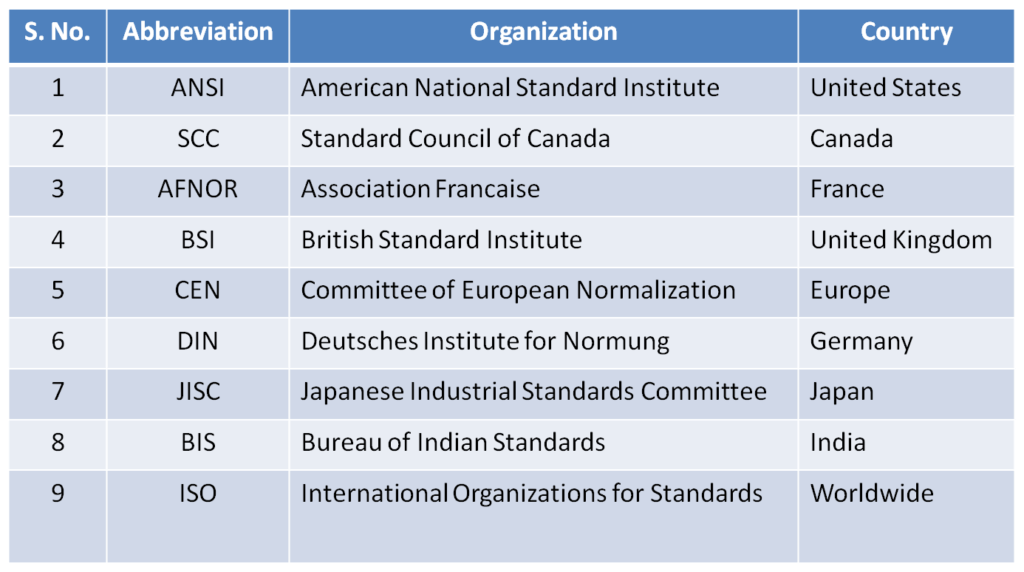
Specifications:
A specification provides specific requirements for the materials, components or services used in an application. Sometimes, a specification will also dictate a standard installation or design layout of those components. Specification requirements may go above and beyond code or standard requirements.
ANSI: the American national standards institute is an apex body that presides over a large number of societies, associations and Institutions’ which in turn govern industrial norms in their respective fields.
ASME: American society of mechanical engineers an engineering society, a standards organization, research, and development organization, an advocacy organization, a provider of training and education, and a nonprofit organization.
ASME Code BPVC (Boiler and Pressure vessel code ) is a code of construction for boilers and pressure vessels formulated by ASME. It is a manufacturer’s code and is reviewed every year hence making it a live and up to date code.
Quick Fact: U-Stamp When a pressure vessel was specified, designed, fabricated, inspected and tested in accordance with ASME BPVC code it is called a U-Stamp Vessel. The ASME “U” stamp is evidence and certification of an unfired pressure vessel built to Section VIII of the ASME Code
A plate with an ASME vessel number is attached to the component. An independent inspector must certify each and every vessel.
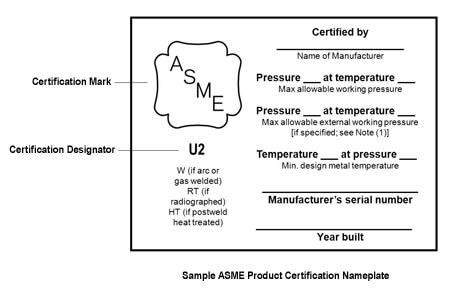
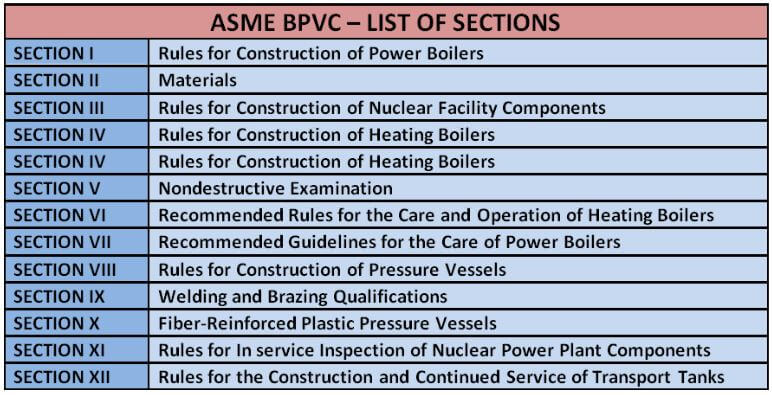
Scope of ASME BPVC SEC -V
(a)ASME BPVC Section V contains requirements and methods for nondestructive examination (NDE) Which are Code requirements to the extent they are specifically referenced and required by other Code Sections or referencing documents.
NDE methods are intended to detect surface and internal imperfections in materials, welds, fabricated parts, and components which include radiographic examination, ultrasonic examination, liquid penetrant examination, magnetic particle examination, eddy current examination, visual examination, leak testing, and acoustic emission examination.
Nonmandatory Appendix A of Article 1 Contains a listing of common imperfections and damage mechanisms, and the NDE methods that are generally capable of detecting them.
(b) general terms such as inspection, flaw, discontinuity, evaluation, etc., are provided in Mandatory Appendix I.
(c) New editions of Section V may be used beginning with the date of issuance and become mandatory 6months after the date of issuance unless modified by the referencing document.
(d) Code Cases are permissible and may be used, beginning with the date of approval by ASME. Only Code Cases that are specifically identified as being applicable to this Section may be used.
At the time a Code Case is applied, only the latest revision may be used. Code Cases that have been incorporated into this Section or have been annulled shall not be used unless permitted by the referencing Code.
Qualifications using the provisions of a Code Case remain valid after the Code Case is annulled. The Code Case number shall be listed on the NDE Procedure or Personnel Certification, as applicable.
Note: In the event, if there is an urgent need for alternative rules concerning materials, construction, or in-service inspection activities not covered by existing Boiler and Pressure Vessel Code rules, or for early implementation of an approved Code revision, ASME issues a Code Case which is effective immediately upon ASME approval and do not expire.
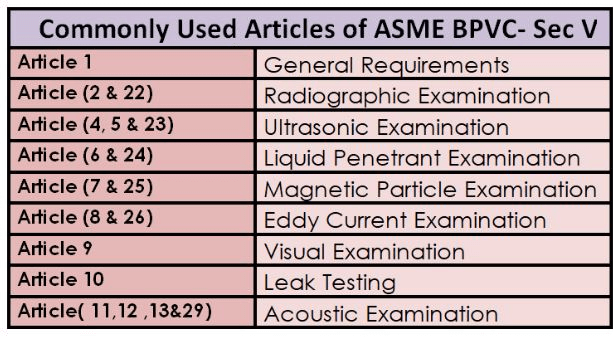
Articles mentioned in the above tables are used in general for a vast variety of Products in the industry. In upcoming articles, we will learn specifically about guidelines and requirements in specific Articles.
Till then keep learning. There is still a lot more to explore.
References:
https://www.theprocesspiping.com/codes-standards-and-recommended-practices/
Quora
https://en.wikipedia.org/wiki/Main_Page
http://www.wermac.org/societies/asme_bpvc.html
ASME BPVC Sec – V
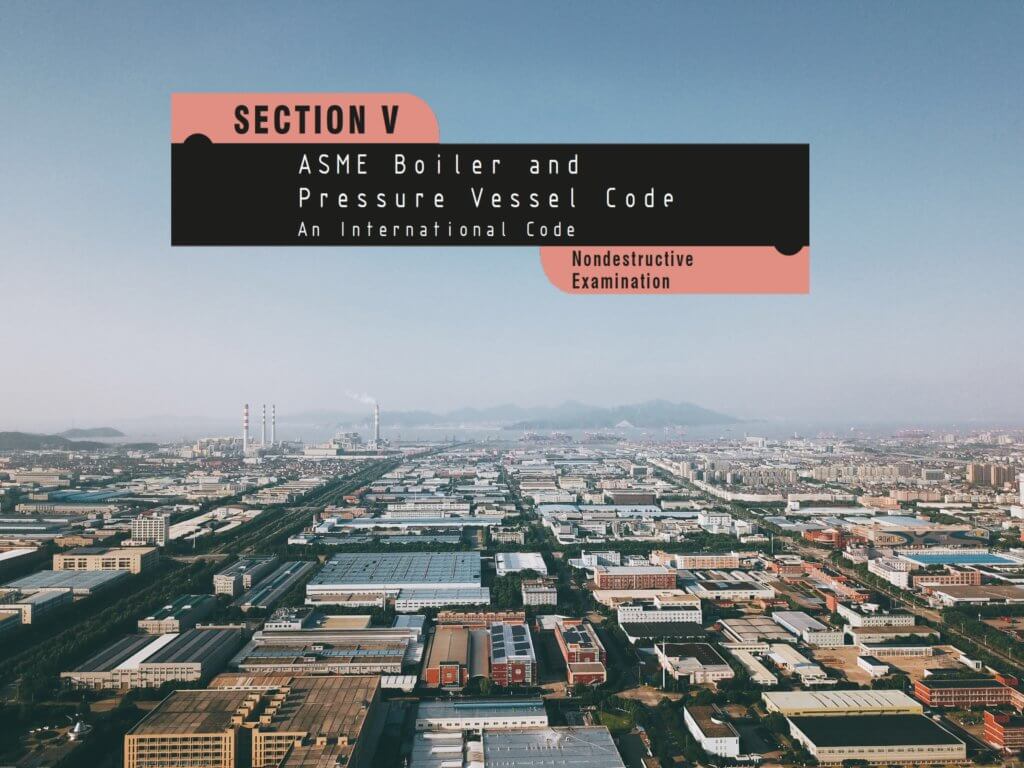
Say, you got a nice post.Really thank you! Really Great.
Say, you got a nice blog post.Really looking forward to read more. Fantastic.
Enjoyed every bit of your blog post.Thanks Again. Keep writing.
Thanks for sharing, this is a fantastic article post.Really thank you! Cool.
Very neat article.Thanks Again. Awesome.
I truly appreciate this article post.Thanks Again. Great.
I really like and appreciate your article post.Really thank you! Much obliged.